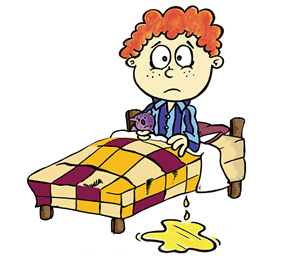
Bedwetting (enuresis) is unintentional urination while asleep. It could be part of normal bladder development or a cause for concern. Most kids are toilet trained by 4 years old, and less than 5% of kids are still wetting the bed between ages 8-11. Here’s some quick tips to help you figure out the difference.
- If your child is bedwetting below age 7, and no external cause is in play, you will most likely be reassured if you see a healthcare professional. Specific treatments for bedwetting aren’t started until at or after age 7.
- If bedwetting occurs in conjunction with foul-smelling urine, pain or other discomfort with urine, urinary frequency or enhanced urge to go during the day, your child could have a bladder (urinary tract) infection. Symptoms may be resolved with antibiotics.
- If bedwetting occurs in conjunction with a change in urinary color, this could be a medical issue. Changes could include urine becoming pink, cloudy, bloody or clear.
- Many children who wet the bed also have constipation. Resolving constipation has been shown to resolve bedwetting in up to 60% of children. Be on the lookout for this.
- Is the bedwetting occurring with snoring? This could be a sign of sleep apnea.
- It is very important for parents to appreciate the behavioral components in play. Stress can be a significant contributor to bedwetting. If you reinforce positive behaviors, resolution of bedwetting may occur sooner than otherwise. If you are relatively unsupportive and critical, symptoms may linger and become more profound. Techniques such as gold stars and other rewards have proven to be effective.
Despite the topic, this post was intentionally dry. Good luck.
